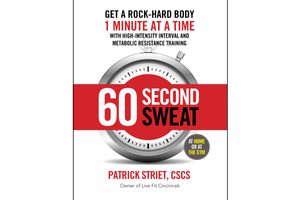Is High-Intensity Interval Training that Much Better Than Cardio?
Updated: Jan. 10, 2017
Keep your metabolic flame burning with this intense workout method.

High-intensity interval training (HIIT) is, in very simple terms, is alternating bouts of intense exercise with less intense “rest” periods. For example, you might run as fast as you possibly can for the entire length of a football field and then walk around the end zone for 30 to 60 seconds before repeating again. (HIIT is also the foundation of my breakthrough fitness plan to lose weight in less time.)
Why does this work? Exercise is like lighting a fire to your metabolism. When you are active, your metabolic flame and your caloric expenditure increases to varying degrees. With traditional, low- to moderate-intensity exercise—like walking on a treadmill or using an elliptical trainer for 30 minutes at a steady pace—you light the flame and it slowly increases to a gradual burn. When you end the workout, the flame dies down quickly and abruptly . . . kind of like dumping water on it.
On the contrary, with HIIT, the high-intensity exercise creates a huge metabolic disturbance and the flame heats up rapidly. Each interval is like squirting lighter fluid on the fire. What’s more, after a HIIT workout, the flame gradually burns down and simmers for a long time. Have you ever lit a fire, let it burn all night, and found that the coals were still hot and glowing in the morning? That’s HIIT, and that’s the effect it has on your metabolism: It’s intense, and you continue burning calories even when the workout is complete.
This is called excess post-exercise oxygen consumption, or EPOC: Following an exercise session, oxygen consumption (and thus caloric expenditure) remains elevated as the working muscle cells restore physiological and metabolic factors in the cell to pre-exercise levels. This is what traditional cardio can’t accomplish: A review article published in the Journal of Sports Sciences notes that exercise-intensity studies indicate higher EPOC values with HIIT training as compared with low- to moderate-intensity steady-paced cardiovascular training. And it doesn’t take long for these benefits to kick in. A team from the University of Guelph in Canada showed that fat oxidation, or fat burning, was significantly higher after six weeks of interval training. Another study out of the University of Guelph showed a similar shift in as little as two weeks.
HIIT also turns out to be better at developing cardiovascular fitness, or conditioning, than traditional cardio training. Cardiovascular function is often measured by maximal oxygen consumption, commonly called maximal aerobic capacity or VO2max (maximal volume of oxygen). The uppermost ability of the body to consume, distribute, and utilize oxygen for energy production, VO2max is a good predictor of exercise performance. In what is the most comprehensive (and recent) study comparing HIIT and traditional, longer-duration cardio, Jenna Gillen found that 12 weeks of sprint training (three sessions per week for a total of 10 minutes per session) on a stationary cycle, consisting of only three 20-second all-out sprints separated by two-minute recovery periods, led to the exact same improvements (20 percent) in aerobic fitness and insulin resistance as three 45-minute continuous sessions at a moderate intensity. Think about that: The HIIT group exercised for only six hours—as compared to 27 hours in the traditional cardio group—and got the same results!
A French study measured VO2max responses among two groups of men and women; one group participated in an eight-week HIIT program; the other, in a traditional steady-paced cardiovascular training program. The HIIT group saw higher VO2max increases (15 percent) than the group doing traditional steady-paced cardiovascular training (9 percent). Improving cardio-vascular function and increasing VO2max are major goals of patients who suffer from heart disease. For this reason, some cardiac rehabilitation centers are beginning to include interval-training sessions with heart disease patients. Results show improvements similar to traditional low-intensity cardio, but in a shorter time and with fewer sessions.
The take-home message? When compared with traditional low- to moderate-intensity continuous cardio, HIIT will allow you to:
- Burn fat faster.
- Burn more calories after your workout is over.
- Develop the same or better cardiovascular conditioning in a fraction of the time.
The workouts in each phase of my 60-Second Sweat program will always incorporate HIIT: You will work really hard for less than a minute—the 60-second promise—and then you’ll recover just long enough for you to do it again. This format will develop your cardiovascular fitness, which in turn can lower your blood pressure and cholesterol levels, protect against heart disease and diabetes, increase bone density, improve sleep quality, and even help you live longer.

For my exclusive workout plans that incorporate HIIT to help you sculpt the body you want and lose weight with less time in the gym, check out my new book 60 Second Sweat.